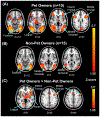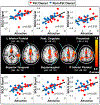Neural correlates for perception of companion animal photographs
- PMID: 27020140
- PMCID: PMC6502473
- DOI: 10.1016/j.neuropsychologia.2016.03.018
Neural correlates for perception of companion animal photographs
Abstract
Anthrozoological neuroscience, which we propose as the use of neuroscience techniques to study human-animal interaction, may help to elucidate mechanisms underlying the associated psychological, physiological, and other purported health effects. This preliminary study investigates the neural response to animal photographs in pet owners and non-pet owners, and both attraction and attachment to companion animals as modulators of human perception of companion animal photographs. Thirty male participants, 15 "Pet Owners" (PO) and 15 "Non-Pet Owners" (NPO), viewed photographs of companion animals during functional MRI (fMRI) scans at 3 T and provided ratings of attraction to the animal species represented in the photographs. Fourteen subjects additionally submitted and viewed personal pet photographs during fMRI scans, and completed the Lexington Attachment to Pets Scale (LAPS). PO exhibited greater activation than NPO during the viewing of animal photographs in areas of the insula, and frontal and occipital cortices. Moreover, ratings of attraction to animals correlated positively with neural activation in the cingulate gyrus, precentral gyrus, inferior parietal lobule, and superior temporal gyrus during the viewing of representative photographs. For subjects with household pets, scores on the LAPS correlated positively with neural activation during the viewing of owned pet photographs in the precuneus, cuneus, and superior parietal lobule. Our preliminary findings suggest that human perception of companion animals involve the visual attention network, which may be modulated at the neural level by subjective experiences of attraction or attachment to animals. Our understanding of human-animal interactions through anthrozoological neuroscience may better direct therapeutic applications, such as animal-assisted therapy.
Keywords: Anthrozoological neuroscience; Companion animals; Human-animal interaction; Pet ownership; fMRI.
Copyright © 2016 Elsevier Ltd. All rights reserved.
Figures




Similar articles
-
Are emotionally attached companion animal caregivers conscientious and neurotic? Factors that affect the human-companion animal relationship.J Appl Anim Welf Sci. 2015;18(3):239-58. doi: 10.1080/10888705.2014.988333. Epub 2014 Dec 17. J Appl Anim Welf Sci. 2015. PMID: 25517173
-
Cortical correlates of vestibulo-ocular reflex modulation: a PET study.Brain. 2003 Jul;126(Pt 7):1562-78. doi: 10.1093/brain/awg165. Epub 2003 May 21. Brain. 2003. PMID: 12805122
-
Where is your shoulder? Neural correlates of localizing others' body parts.Neuropsychologia. 2009 Jul;47(8-9):1909-16. doi: 10.1016/j.neuropsychologia.2009.03.001. Epub 2009 Mar 9. Neuropsychologia. 2009. PMID: 19428423
-
Companion Animal Fostering as Health Promotion: A Literature Review.Int J Environ Res Public Health. 2023 Jun 21;20(13):6199. doi: 10.3390/ijerph20136199. Int J Environ Res Public Health. 2023. PMID: 37444047 Free PMC article. Review.
-
Companion Animals and Health in Older Populations: A Systematic Review.Clin Gerontol. 2020 Jul-Sep;43(4):365-377. doi: 10.1080/07317115.2019.1650863. Epub 2019 Aug 17. Clin Gerontol. 2020. PMID: 31423915
Cited by
-
Pet ownership is associated with greater cognitive and brain health in a cross-sectional sample across the adult lifespan.Front Aging Neurosci. 2022 Oct 20;14:953889. doi: 10.3389/fnagi.2022.953889. eCollection 2022. Front Aging Neurosci. 2022. PMID: 36337704 Free PMC article.
-
Effects of contact with a dog on prefrontal brain activity: A controlled trial.PLoS One. 2022 Oct 5;17(10):e0274833. doi: 10.1371/journal.pone.0274833. eCollection 2022. PLoS One. 2022. PMID: 36197880 Free PMC article. Clinical Trial.
-
Six types of loves differentially recruit reward and social cognition brain areas.Cereb Cortex. 2024 Aug 1;34(8):bhae331. doi: 10.1093/cercor/bhae331. Cereb Cortex. 2024. PMID: 39183646 Free PMC article.
-
The neural basis of understanding the expression of the emotions in man and animals.Soc Cogn Affect Neurosci. 2017 Jan 1;12(1):95-105. doi: 10.1093/scan/nsw161. Soc Cogn Affect Neurosci. 2017. PMID: 27803286 Free PMC article.
-
Cognitive mechanisms and neurological foundations of companion animals' role in enhancing human psychological well-being.Front Psychol. 2024 Apr 24;15:1354220. doi: 10.3389/fpsyg.2024.1354220. eCollection 2024. Front Psychol. 2024. PMID: 38721326 Free PMC article. Review.
References
-
- Angulo FJ, 1999. Pet ownership among HIV-infected persons in the Multicenter AIDS Cohort Study: Health Risk or psychological Benefit? Dissertation Abstracts International: The Sciences and Engineering. 56, 5444.
-
- Allen K, Blascovich J, Mendes WB, 2002. Cardiovascular reactivity and the presence of pets, friends, and spouses: the truth about cats and dogs. Psychosom Med. 64 (5), 727–739. - PubMed
-
- Banks MR, Banks WR, 2002. The Effects of Animal-Assisted Therapy on Loneliness in an Elderly Population in Long-Term Care Facilities. The Journals of Gerontology Series A: Biological Sciences and Medical Sciences. 2002 July 1 57 (7), pp. M428–M32. - PubMed
-
- Bass MM, Duchowny CA, Llabre MM, 2009. The effect of therapeutic horseback riding on social functioning in children with autism. J. Autism Dev. Disord. 39 (9), 1261–1267. - PubMed
-
- Berget B, Braastad BO, 2011. Animal-assisted therapy with farm animals for persons with psychiatric disorders. Ann. Ist. Super Sanita. 47 (4), 384–390. - PubMed
Publication types
MeSH terms
Substances
Grants and funding
LinkOut - more resources
Full Text Sources
Other Literature Sources

